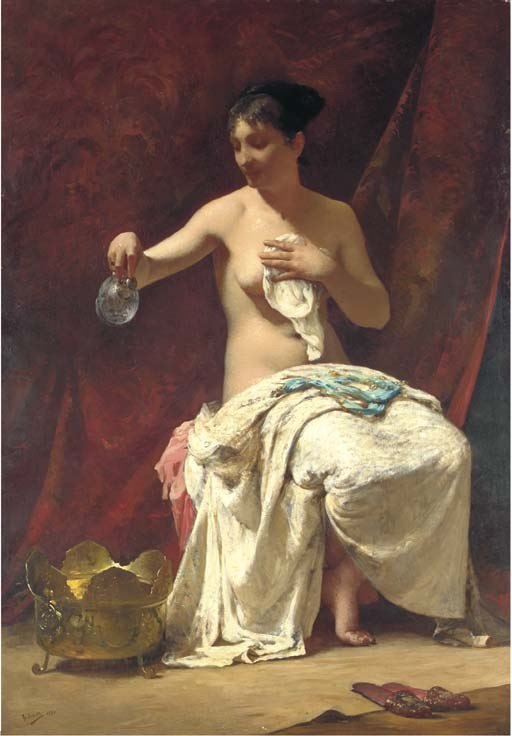
The Organ Rehearsal, 1885
Henry Lerolle was born on October 3, 1848 in Paris. He studied at the popular 19th century Académie Suisse, whose alumni include Monet, Cézanne, Pissaro, and Manet amoung others, and under the private instruction of Louis Lamothe, who taught Degas and Tissot. Despite his incredible eye there seems to be a lack of productivity compared to his contemporaries yet what makes Lerolle unique is his dramatic use of light and bold colors.
In The Organ Rehearsal above, we see one of the most breathtaking and underrated paintings of the 19th century. A singer rehearses a hymn at the Saint-François-Xavier in Paris to an open space of light— a brilliant composition that eschews any audience below completely and focuses on the main figures of the choir loft. This remarkable earth toned palette of browns, yellows and blacks, with a few accent colors, is superb. A couple of the standing figures off to the left have been painted in burnt sienna and yellows that make their faces glow—the one with the beard lost in a gaze is Lerolle himself. Look at the crisp lines of the interior cornices, engaged columns, and pilasters...how they contrast with the scumbled warm tones of the loft. Lerolle is a keen observer of facial expressions and body language. I love that singer reading from that sheet with her lips parted in song...she alone would have made a great painting. Note the woman watching keenly from the left with matching hat, who is watching her sister singing. The young woman in brown is Lerolle's wife. I also admire Lerolle's use of small details to enliven the painting, such as the thick music books strewn across the floor beside his wife and on her lap. Lerolle provides us visually with a space for a voice that we can imagine in our heads, something rarely depicted in art. Simple. And brilliant.

Reading Woman, ca. 1890
This feels like a scene from a film...easy to see how modern day cinematographers are influenced by art. Look at the way the sun backlights her hair and the letter she is reading reflects some of that warm light gently onto her face and neck. Lerolle uses a complementary palette of green and red that is balanced by her white blouse and the white building behind her in the distance. Lerolle creates the impression of urgency in the way she reads so that we can almost see her eyes darting impatiently across the page, and yet the details of her face are vague. Placing a figure in the middle of a composition is a daring move for any artist, yet Lerolle knew that this was the only way to focus on this lovely woman. By arranging her in a three-quarter pose it makes the figure less confrontational and pulls us into the drama. Even that pink-tiled roof off to the far top right eases the contrast of the dress and grass. This would be a great painting to see up close in person.

Femme a sa toilette, 1877
Another painting that should be seen up close in person. Lerolle uses a dramatic red curtain with a vibrant pattern as a backdrop for this elegant and lovely nude. Look at the texture of the drapery atop of her lap. The woman cleans herself while pouring a small pitcher of water into an golden ornate urn of some sort...look at how that light from high above left of the composition falls down upon her, casting a deep shadow under her arm and breast. This is not the work of a second-rate artist but of a discreet master with deep respect for his subjects. Beautiful.

Femme a la lecture, ca. 1900
Here we see brushwork directly inspired by Lerolle's good friend Degas. The palette here is quite warm with yellows, oranges and reds that Lerolle balances with white and a surprising accent colour: blue. Despite the cluttered interior we are drawn to the woman reading intently on the corner-sofa, and the way Lerolle paints the walls and area rug the brushwork seems to vibrate, as if suggesting the drama of what she is reading. Look at the thick impasto strokes of the transparent drapes in the window, in scumbled dry greys. This painting may lack the sheer drama and light of the earlier woman outside in the sunlight, but it has something else...an immediacy, a quiet presence.
Lerolle may not be a Degas or Monet, but his striking work deserves mention as an artist who enjoyed some recognition in his time, yet forgotten largely in ours. What captures my attention is his versatility and vision, able to find narrative in the simpest moments and with an eye unlike many of his contemporaries, he breathed life into his subjects by making the space they reside in part of their world.
Comments
Post a Comment